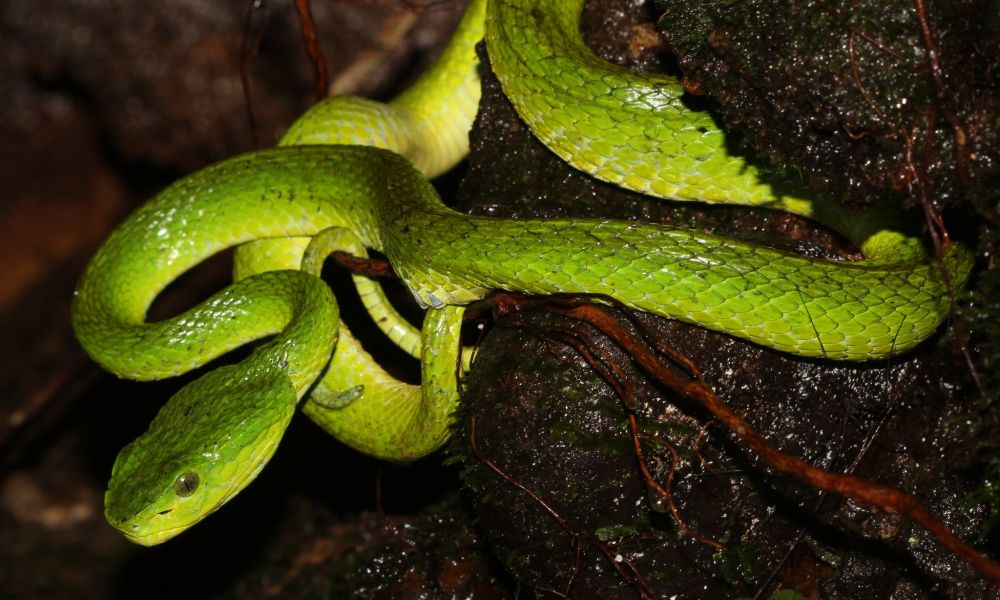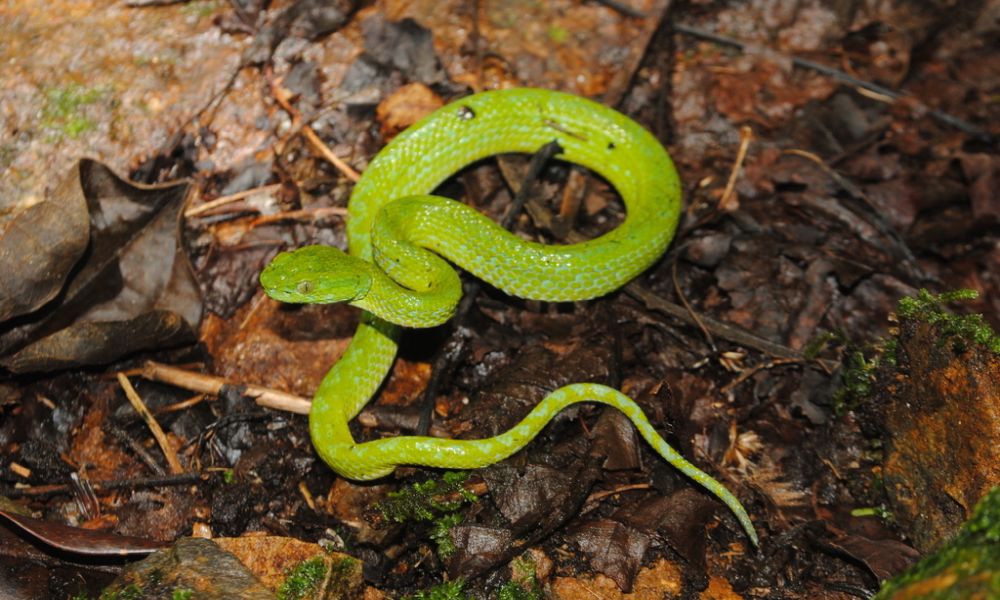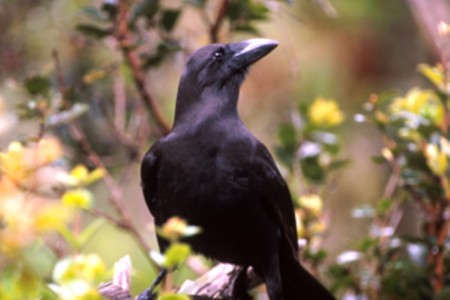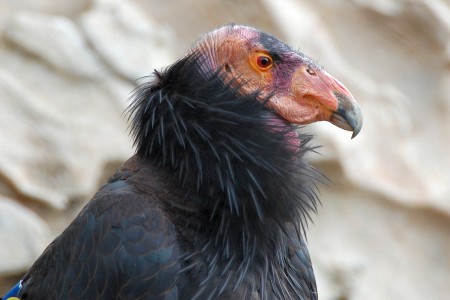

March’s Palm Pit Viper
Racing Against Time to Save Them

INTRODUCTION
March’s Palm Pit Viper (Bothriechis marchi), also known as the Honduran Palm Pit Viper, is an intriguing species found in the cloud forests of Honduras. Renowned for its striking appearance, this snake has become a symbol of the rich biodiversity of its native habitat. The viper was named in honor of a well-known herpetologist, Douglas H. March, who died in 1939 after being bitten by a fer-de-lance, a venomous snake of the viper family. (The French name fer-de-lance means spearhead.)
Scientific Classification
• Kingdom: Animalia
• Phylum: Chordata
• Class: Reptilia
• Order: Squamata
• Family: Viperidae
• Genus: Bothriechis
• Species: B. Marchi
Appearance and Behavior
The March’s Palm Pit Viper’s coloration varies from pale to dark green, and the pattern helps it camouflage amidst the forest foliage. This natural coloration aids it in hunting, as it blends with the leaves and branches. The body length is about 31 – 38.1 in ( 80cm—96.8cm).
The March’s Palm Pit Viper is recognized for its arboreal nature, spending most of its time in trees. This behavior makes it distinct from other pit vipers, offering an adaptation that leverages the vertical dimension of its habitat. Also, it can remarkably sense heat through specialized organs near its eyes.
These highly sensitive pits can detect tiny temperature changes, allowing the viper to locate its prey even in complete darkness. While potent and used to subdue prey, their venom is not typically fatal to humans. However, it is vital to approach this viper with caution and respect, as its bite can cause severe reactions.
An exciting aspect of the March’s Palm Pit Viper is its hunting method. They use a sit-and-wait strategy, remaining motionless and striking quickly when prey comes within range. This efficient hunting technique conserves energy and makes them successful predators.
Habitat and Ecology
The March’s Palm Pit Viper is found in humid and montane forests of the mainland of Honduras and eastern Guatemala. This snake thrives in subtropical, tropical moist lowland, and montane forests. Under natural conditions, its estimated lifespan is around 15-20 years, and its diet consists primarily of small mammals, birds, and amphibians.
Regarding reproduction, March’s Palm Pit Vipers are viviparous, meaning they give birth to live young instead of laying eggs. During mating, the male aligns his body with the female and inserts one of his two hemipenes. The female then gives birth to about 12 to 20 live young, who are capable of fending for themselves immediately after birth.
Conservation Status
March’s Palm Pit Viper is a distinct reptile that exemplifies the rich diversity of the animal kingdom. Its unique heat-detecting organs, tree-dwelling habits, and live birth reproduction process witness the intricate and awe-inspiring blueprint of nature.
Regrettably, this species is facing a steep decline in numbers. Since 2012, it has been categorized as Endangered on The International Union for Conservation of Nature’s Red List of Threatened Species, highlighting an urgent need for protection and conservation efforts.
THREATS TO MARCH'S PALM PIT VIPERS

Habitat Destruction
The cloud forests that the March’s Palm Pit Viper calls home are under significant threat due to rampant deforestation and urban development. These unique habitats are being destroyed at an alarming rate due to logging, farming or agriculture, and the expansion of human settlements. This loss of habitat leads to a decrease in shelter and food sources, significantly affecting the viper’s survival.
The greatest danger to the species is their presence in isolated areas. Any further loss of mature forest areas leads to fragmentation, which, because their habitats are already fragmented, presents severe threats to the species. Conservation efforts must include the protection, restoration, and sustainable management of these forests, considering the needs of both the viper and other species that share the habitat.
Illegal Collection
Illegal collection for the pet trade poses a substantial threat to March’s Palm Pit Viper. The species’ beautiful coloration and rarity make it a highly sought-after commodity among collectors, leading to poaching from the wild. This illegal trade not only depletes the natural population but also exposes the snakes to stress and potential diseases during capture and transportation.
Stricter laws and regulations are needed to combat this problem, along with increased enforcement and education among pet trade stakeholders. Cooperation among governments, NGOs, and the private sector can strengthen efforts to halt this illegal trade. The Honduran authorities have issued permits for the exportation of hundreds of individuals annually (J. Townsend, unpubl. data).
Human Conflict
As human settlements expand into the viper’s habitat, conflicts between the snake and local communities become more common. These conflicts often lead to the unnecessary killing of the snake out of fear, ignorance, or misunderstanding. Local education programs focusing on the importance of the viper and safe interaction strategies are critical in reducing these conflicts. Community engagement and creating safe spaces for the snake can further foster coexistence and protect the species from retaliatory killings or unintentional harm.
Predation
Predation, while a natural part of the ecosystem, has become a growing concern for the March’s Palm Pit Viper due to habitat fragmentation and environmental imbalance. Birds, mammals, and other snakes prey on the viper, and this predation can lead to significant population decline, particularly when combined with other threats like habitat loss.
Comprehensive habitat preservation can address this issue by maintaining a balanced ecosystem where the viper and its predators can coexist. Research and monitoring can also help understand the patterns of predation and develop strategies to mitigate its impact. The crash in amphibian populations threatens this species.
Climate Change
Climate change has emerged as a subtle yet potentially devastating threat to the March’s Palm Pit Viper. The cloud forests’ unique microclimate, characterized by stable temperature and humidity, is sensitive to global weather pattern changes. Shifts in these patterns can affect the snake’s prey availability, shelter, and overall living conditions.
Long-term studies, constant monitoring, and adaptive management strategies must be implemented to gauge these impacts and develop responsive actions. Collaborative international efforts can provide the resources and expertise needed to address this complex threat.
Disease
March’s Palm Pit Viper is susceptible to various diseases, including fungal infections, respiratory ailments, and parasitic infestations. These diseases can be particularly devastating in smaller, isolated populations, where rapid spread can lead to significant mortality. Increased genetic diversity, regular health monitoring, and proactive disease management can enhance resilience against these ailments.
Collaboration between veterinarians, wildlife biologists, and conservationists can develop effective healthcare protocols to detect, treat, and prevent these diseases, supporting the overall well-being of the species.
Conservation Efforts
Conservation efforts for the March’s Palm Pit Viper are multifaceted, encompassing habitat protection, law enforcement against illegal collection, and educational outreach. International cooperation and strong commitment from local governments and organizations are vital to building and maintaining these efforts. Habitat protection must include the creation and effective management of protected areas, combined with sustainable land use practices that accommodate both human needs and wildlife conservation.
Community-based conservation, where local communities are engaged and empowered in conservation actions, can foster a sense of ownership and create lasting positive impacts. Continued research, funding, and public awareness campaigns can further strengthen these efforts, creating a comprehensive strategy to ensure the species’ survival.
Conclusion
March’s Palm Pit Viper is more than just a beautiful snake; it is a remarkable species that plays an essential role in its ecosystem. However, it faces an array of threats that could lead to its decline or even extinction if not addressed. From habitat loss and human conflict to diseases and climate change, these challenges are complex and interrelated. They require a holistic, collaborative approach that involves governments, conservation organizations, scientists, local communities, and the broader public. Through concerted efforts and a shared commitment to conservation, it is possible to ensure that March’s Palm Pit Viper continues to thrive in its natural habitat, preserving a unique part of our planet’s biodiversity.
IMPORTANCE OF MARCH'S PALM PIT VIPERS

Effects on Local Ecosystems
The decline in the population of March’s Palm Pit Viper has serious consequences for its local ecosystem. Below are some ways in which the Palm Pit Viper contributes to the ecosystem:
- Predator Role: Snakes often act as predators in their ecosystems, helping to control populations of rodents, insects, and other small animals. Keeping these populations in check prevents overgrazing or overconsumption of plants, contributing to a balanced ecosystem. As a predator, it helps control the population of its prey, maintaining a delicate balance within the ecosystem. A decline or extinction can disrupt food chains, lead to overpopulation, decrease other species, and potentially cause more extinctions.
- Prey Role: Conversely, they prey on larger predators such as birds of prey, mammals, and other snakes. This links the food chain and helps energy transfer across different trophic levels.
- Disease Control: Snakes can indirectly help control disease spread by preying on rodents and other animals that may carry diseases.
- Snakes are an indicator of Ecosystem Health. They respond to changes in their environment, and their presence or absence can indicate an ecosystem’s overall health.
Role in Climate Change Mitigation
While some species in the natural world are recognized for their direct roles in maintaining ecological balance, such as seed dispersal or carbon sequestration, other organisms like the March’s Palm Pit Viper are not directly involved in these processes. Yet, their role in maintaining the ecological equilibrium is incredibly vital in climate change control.
As a predator, the March’s Palm Pit Viper is crucial in controlling the populations of various prey organisms, including rodents and insects. By keeping these populations in check, the viper ensures that vegetation is protected from overgrazing or overuse. Plants and trees are critical in carbon sequestration by absorbing atmospheric carbon dioxide. The March’s Palm Pit Viper indirectly contributes to this process by protecting vegetation by controlling herbivorous prey. If vegetation were to decline due to overgrazing, the ability of the ecosystem to sequester carbon would diminish, exacerbating climate change.
The role of the March Palm Pit Viper in climate change control reminds us of the complexity of ecosystems. No matter how seemingly insignificant, every species plays a part in maintaining ecological balance.
Impact on Medical Research and Healthcare Costs
Venom from snakes like March’s Palm Pit Viper has promising applications in medical research, including pain management and treatment for heart conditions. The decline of this species could hinder medical advancements, leading to increased healthcare costs in developed nations that rely on such research.
Loss of Potential Ecotourism Opportunities
The March’s Palm Pit Viper, with its beautiful coloration and unique habitat, has significant potential for ecotourism. A decline in their numbers results in lost opportunities for ecotourism, impacting local communities that could benefit from tourism revenue and thus affecting global economies.
HOW TO HELP MARCH'S PALM PIT VIPERS

Like hundreds of thousands of other species under threat, the March’s Palm Pit Viper is experiencing a severely decreasing population requiring urgent conservation endeavors.
Immediate Financial Impacts
Conservation efforts do not come on the cheap. This species requires costly, immediate attention and funds for research and protection initiatives. While local governments and entities work to provide funds and persons to take on the task, additional funds and support are derived from international organizations and governments, financed in part by taxpayers in developed nations. Costs include expenses related to scientific studies, habitat protection, and indirect ones tied to enforcing protective measures.
Biodiversity loss, a phenomenon witnessed in the decline and potential extinction of many species, including March’s Palm Pit Viper, presents a significant global crisis. This issue, however, extends far beyond the immediate observable effects. It compromises the stability of ecosystems, disrupts the harmony of traditional livelihoods, and can potentially trigger domino effects that can affect life on Earth as we know it. The approach to addressing biodiversity loss must be multifaceted, necessitating individual, community, and global action. The formulation and implementation of effective conservation measures hinge on understanding the complex interdependence of various life forms and the extensive repercussions of biodiversity loss.
Help to Educate
Acquiring in-depth knowledge about March’s Palm Pit Viper and the severe ramifications of its potential extinction provides a basis for understanding the urgency of the crisis. With this knowledge, individuals can effectively advocate for protecting this pit viper by using social media platforms, delivering public talks, hosting events, or engaging in meaningful personal conversations. The goal is to increase public awareness about the threats facing these species and , promote potential solutions which will bring in more individuals actively participating in conservation efforts.
Assist Local Communities
Local communities cohabit with many endangered species, making them significant stakeholders in conservation efforts. Their involvement is critical if the March’s Palm Pit Viper and others are to survive. Implementation of sustainable farming practices, efforts to prevent habitat destruction, and active participation in local conservation initiatives all play a part, and education plays a pivotal role because it enables communities to recognize the ecological importance of this species, which can trigger increased involvement in conservation efforts.
Defeat Climate Change
Global climate change presents a broad range of threats to many species, including March’s Palm Pit Viper. Adopting environmentally friendly practices such as minimizing waste generation, transitioning to renewable energy sources, and promoting sustainable consumption patterns can help mitigate the impacts of climate change. These practices collectively contribute to improving the planet’s overall health, directly influencing the survival prospects of endangered species.
Defeating climate change and pollution are herculean tasks that will not be defeated by mitigating personal actions alone. Choosing leaders who agree on reducing carbon emissions and other climate-changing factors is critical in the fight to keep the planet safe for all species, including humans. Please consider the important need for such leaders and join with others to elect them to represent you.
Promote Eco-Tourism
Tourism, when managed responsibly, can be an ally to conservation efforts. Ethical tourism respects the environment and local communities, indirectly contributing to preserving endangered species like March’s Palm Pit Viper. Ethical tourism encourages engagement in low-impact activities that minimize disruption to wildlife and their habitats. It also reinforces local cultures and economies while raising awareness about the importance of biodiversity conservation among tourists.
Stop Illegal Wildlife Trade
Both the legal and illegal wildlife trades pose a significant threat to many species worldwide, including March’s Palm Pit Viper. Taking a decisive stand against such activities by refusing to support the market for wildlife products and advocating for more robust wildlife protection laws can go a long way in curtailing the demand that drives this damaging industry. Increased public awareness about the devastating impacts of illegal wildlife trade can add impetus to global efforts aimed at combating it.
Support Conservation Organizations
Conservation organizations, operating at both local and global levels, play a vital role in countering biodiversity loss. They are involved in conducting crucial research, advocating for wildlife-friendly policies, and implementing conservation projects. Lending support to organizations like the World Wildlife Fund, either through financial donations, volunteering, or by amplifying their work, can considerably enhance their capacity to protect endangered species like March’s Palm Pit Viper. Here are a few that support this species:
- The International Reptile Conservation Foundation
- Mesoamerican Development Institute (MDI)
- One Tree Planted
Join Citizen Science Efforts
Projects that involve members of the public in data collection for scientific research are gaining increasing recognition as valuable tools in conservation. Participation in these projects provides researchers with crucial data and actively engages the public in conservation efforts. The data collected can offer insights into trends in population dynamics and other key indicators, aiding in developing effective conservation strategies.
In conclusion, efforts to conserve endangered species like March’s Palm Pit Viper and mitigate biodiversity loss require comprehensive and concerted action at all levels of society. The journey towards effective conservation encompasses raising awareness, advocating for necessary changes, supporting local communities, promoting ethical tourism, preventing illegal wildlife trade, backing conservation organizations, and adopting environmentally friendly practices. Each of these small but significant steps contributes to the larger objective of preserving the Earth’s biodiversity and fostering a sustainable future for all species.
The interconnected and global nature of biodiversity loss means that every individual has a role to play in conservation efforts. By taking small steps, each of us can contribute to preserving the intricate web of life on Earth. As we strive to protect species like March’s Palm Pit Viper, we’re not only working to prevent the extinction of a single species but also defending the delicate balance of ecosystems that sustain all forms of life.












